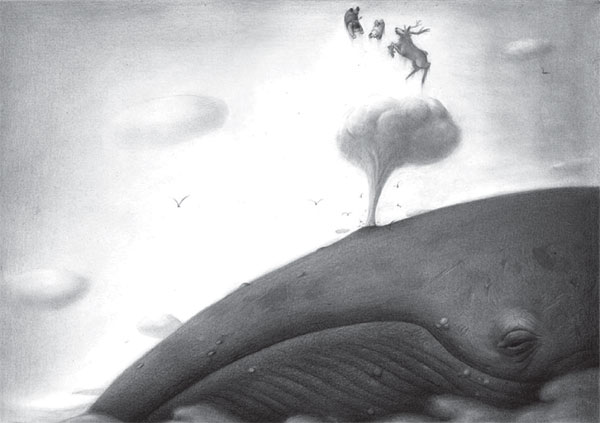Book on an only child has a crowded fanbase
|
The book The Only Child follows the adventures of a young girl on the way back home. Provided to China Daily |
In her first effort, Chinese illustrator has hit based on her childhood experiences
A Chinese illustrator's debut book, which was inspired by her experiences as an only child, has been named as one of the best children's books of 2015.
The Only Child by Guo Jing has received critical acclaim and was selected from thousands of titles for best-of lists published by The New York Times and the Washington Post.
Released in the United States in December, the book sold out on Amazon within two weeks, although as the author explains, "That's partly because only 10,000 books were printed for the first edition. A second edition will be printed soon."
The pencil-drawn story follows the adventures of a young girl who falls asleep on a bus and gets lost in a forest, where she meets a flying deer, a whale and a seal that help her return home.
"It's not just a tale of fantasy; it also reflects the lonely life of an only child in China in the 1980s," says Guo, 32, who based the story on her experiences growing up in Taiyuan, Shanxi province.
One day, she recalls, her father was in a rush to get to work and had left her at a bus stop to travel to her grandparents' home. Like her character in The Only Child, Guo fell asleep on the way. When she awoke and got off the bus, she was in an unfamiliar forest.
"I felt scared and extremely lonely," she says.
Guo only started to draw the book only three years ago while working in Singapore as an illustrator. To complete it, she quit her job and moved back to her hometown.
China's one-child policy, which was officially scrapped in 2015, had been in place since the late 1970s. According to estimates by demographer Yi Fuxian, the policy has meant that more than 200 million people grew up as the only child in their family.
However, despite the fact many Chinese would likely empathize with main character, Chinese publishers originally rejected The Only Child when Guo sent out her sketches in 2014.
Eventually, she was offered a deal by Schwartz and Wade, an arm of American publishers Random House. The company also nominated the work for the New York Times children's book list, which is used as a reading guide by many parents.
The work has been compared with that of Chinese-Australian painter Shaun Tan, as well as Raymong Briggs' The Snowman.
After seeing the response in the US, Guo says about 20 Chinese companies contacted her and offered to publish her work. As a result, The Only Child will soon be released in her homeland through China Citic Press.
Although busy with media interviews and e-mails from readers, the artist is now working on her second book, "which might be about a big-mouthed girl".
Guo says she is now more confident about expressing herself and creating her own unique artistic language.
"I used to think art is what you do for the audience, but I finally understand now that art is what you express out of your heart," she says.
yandongjie@chinadaily.com.cn
Expert analysis
Guo Jing drawings show a lonely child playing with imaginary animals, which in psychological terms here are "transitional objects". These animals are actually a substitute for company when the painter feels alone.
The family planning policy introduced by China in the late 1970s has helped prevent a sharp population increase, but it also seems to have had a psychological impact on the generations that followed. Compared with children with siblings, the only child is less willing to share and is more self-centered. Data suggest that those born in the 1980s (after 1985 especially) are more likely to have depression, insecurity or overconfidence.
I believe the two-child policy, which was announced in late 2015, will have a positive effect on future generations. I'm even looking forward to a three-child policy, which I feel is a more optimal number of children for a family. Apart from a sense of sharing, children are more capable of coping with adversity in school and society if they have experience competing and quarreling with siblings.
Hu Deng, director of Renmin University of China's Counseling Center



















